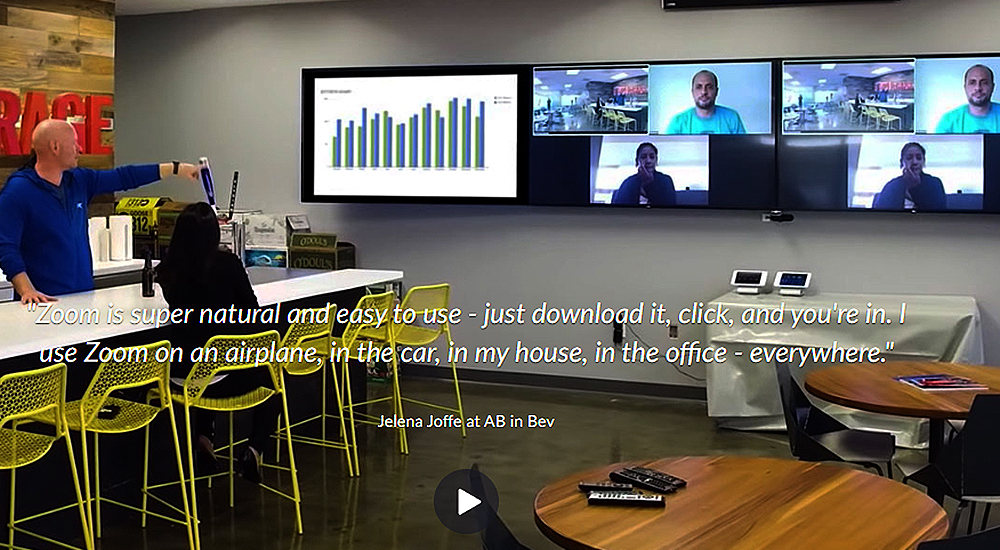Why Zoom is now hosted on Oracle’s cloud infrastructure

During the end of late April, Oracle announced that Zoom Video Communications, driven by accelerated end user usage due to global shelter at home requirements, was now using Oracle Cloud Infrastructure to host its online video meetings. The benefits of the platform adoption have been tremendous for Zoom.
“Zoom has been able to scale from 10 million monthly meeting participants to 300 million monthly meeting participants this month, a 30X increase in overall scale,” says Clay Magouyrk, Executive Vice President Engineering, Oracle Cloud Infrastructure.
Zoom is also taking advantage of the global presence of Oracle Cloud Infrastructure regions to expand its availability. “Zoom is deploying to many of our Oracle cloud regions, which brings them closer to customers and gives confidence to customers around security when it comes to data sovereignty,” adds Magouyrk. Zoom is not in every Oracle Cloud region, and they can choose to use only a couple or all of them.
Oracle itself is expanding the number of regions with Oracle Cloud Infrastructure to 20 regions. Each of the regions needs to have two locations both for disaster recovery and availability due to data regulations and compliance.
The current and future presence of Oracle Cloud Infrastructure regions includes The Bay Area, California; Montreal, Canada; Belo Horizonte, Brazil; Newport, Wales, UK; Amsterdam, The Netherlands; Osaka, Japan; Melbourne, Australia; Hyderabad, India; Chuncheon, South Korea; Singapore; Jeddah, and another city in Saudi Arabia; Dubai, and another city in UAE; Israel; South Africa; Chile; Two government regions in the UK, one in London and one in Newport, Wales; One government region in Israel.
Zoom began engaging with Oracle in the middle of March and within a couple of days their applications were sitting on top of Oracle’s public cloud hosting infrastructure. “Within a week or so they were moving significant production loads over to it and we have steadily ramped that over the course of six weeks or so,” adds Magouyrk.
When Zoom approached Oracle more than a month ago, it was fast running out of overall capacity to host its global, millions of concurrent participant meetings. While Zoom applications were being hosted with multiple cloud service providers and on-site as well, their pain points were their inability to scale rapidly to meet the pandemic fueled demand for effective remote working experiences.
A key customer usage trend in Zoom meetings has been the integration with video connectivity. “They reached out to us to see if we could help meet their scaling demands,” explains Magouyrk.
As a cloud infrastructure provider for Zoom, the challenge is to provide a three-pronged, scalable resource support to manage the consumption demand. Zoom application workloads consume 7 Petabytes of transit data into and out of Oracle Cloud Infrastructure. Converting this into an average consumption figure over 24 hours, Magouyrk works it out to be 600 Gigabits per second, averaged continuously over 24 hours. And when there are peak requirements the network bandwidth requirement shoots even higher.
Elaborates Magouyrk, “They are extremely network bandwidth heavy and they push Terabits of bandwidth out each second, at peak. A large part of what they needed from us was too make sure we had all of the network bandwidth and head room to meet their demands and not start dropping packets. As an infrastructure provider those are the kind of core metrics we are looking at – storage usage, compute usage, network usage.”
Inside Oracle, Zoom is now a significantly large customer, growing very quickly and using a large amount of compute and storage, and huge amounts of bandwidth. “What I look at it, is making sure we have the compute capacity they need and we have all of the network bandwidth they need,” he adds.
Long before Zoom became an Oracle Cloud customer in March this year, Oracle has been using Zoom for its remote workforce meetings. For Oracle, Zoom is the standard virtual meeting tool that it has been using for years. “Zoom is the technology that we have used to stay connected,” remarks Magouyrk.
Oracle Cloud Infrastructure is a second-generation cloud that was built for enterprises from the ground up. The base layer is bare metal compute overlaid with a layer of virtual machines on top of that. This enhances defence of deep inspection into data assets and provides best in class, security portfolio.
“Oracle has been a long-standing enterprise technology provider, which is a huge part of what we do. Since customers run their business-critical stuff on us, we have to operate in that high level of support. This was a big part of why Zoom was able to grow so quickly with us,” summarises Magouyrk.

Key takeaways
- Zoom has been able to scale from 10M monthly meeting participants to 300M monthly meeting participants.
- Zoom is taking advantage of the global presence of Oracle Cloud Infrastructure regions to expand its availability
- When Zoom approached Oracle it was fast running out of capacity to host its global participant meetings.
- Zoom is extremely network bandwidth heavy and they push Terabits of bandwidth out each second.
- What I look at it, is making sure we have the compute capacity they need and all the network bandwidth they need.
- As an infrastructure provider those are the kind of core metrics we are looking at – storage usage, compute usage, network usage.
Challenged by inability to scale fast enough, with a network hungry application, Zoom approached Oracle to help meet its pandemic demand, and met with success.
Clay Magouyrk, Executive Vice President Engineering, Oracle Cloud Infrastructure.





